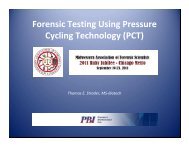pressure cycling technology (pct): applications for forensic dna ...
pressure cycling technology (pct): applications for forensic dna ...
pressure cycling technology (pct): applications for forensic dna ...
Create successful ePaper yourself
Turn your PDF publications into a flip-book with our unique Google optimized e-Paper software.
PRESSURE CYCLING<br />
TECHNOLOGY (PCT):<br />
APPLICATIONS FOR FORENSIC<br />
DNA ANALYSIS<br />
Pam Marshall, MS<br />
Research Appreciation Day, 2010
Current Forensic Need<br />
• Challenged/Degraded Samples and Touch DNA<br />
• Most studies focus on improving “downstream<br />
analysis”<br />
• Low level DNA samples will not yield<br />
reproducible and reliable results<br />
• “Garbage in, garbage out”
Purpose<br />
To increase DNA recovery from devices used<br />
<strong>for</strong> collecting crime scene biological evidence,<br />
such as cotton swabs<br />
Samples containing various amounts of<br />
purified DNA or cells were placed onto swabs<br />
and processed with Pressure Cycling<br />
Technology (PCT).
Pressure Cycling Technology<br />
(PCT)<br />
• PCT is a novel <strong>technology</strong> that uses cycles of<br />
hydrostatic <strong>pressure</strong> between atmospheric and<br />
ultra-high levels (up to 35,000 psi)<br />
• Allows <strong>for</strong> the precise control of biomolecular<br />
interactions
Pressure Cycling Technology<br />
(PCT)<br />
• PCT alters con<strong>for</strong>mations and interactions of<br />
biomolecules<br />
• Destabilizes secondary structures<br />
• Does not denature or inhibit enzymes<br />
• Does not appear to degrade DNA below<br />
levels practical <strong>for</strong> <strong>for</strong>ensic analyses
The Barocycler NEP3229<br />
• Bench top instrument<br />
• External chiller hook-up<br />
• Uses a programmable logic<br />
controller<br />
• Processes up to three<br />
samples simultaneously
The PULSE Tube<br />
Specially designed multi-functional tube:<br />
• Single-use<br />
• Versatile, works with:<br />
- Standard and custom reagents<br />
- Various sample types<br />
- Range of sample sizes<br />
• Convenient<br />
• Efficient<br />
• Safe: closed tube, sample fully-contained
Study Design<br />
• Purified DNA or epithelial cells<br />
• Samples processed with and without PCT<br />
• Samples extracted using DNA IQ Casework Kit on<br />
the Maxwell® 16<br />
• Samples quantified
Maxwell® 16 Instrument<br />
• Easy method <strong>for</strong> efficient,<br />
automated DNA purification<br />
• Preprogrammed purification<br />
procedures<br />
• Use with predispensed<br />
reagent cartridges<br />
• Processes up to 16 samples<br />
in approximately 30 minutes
DNA Recovery (ng/µl)<br />
0.35<br />
0.3<br />
0.25<br />
0.2<br />
0.15<br />
0.1<br />
0.05<br />
0<br />
Tube Transfer<br />
(Purified DNA Swabs)<br />
Pressure<br />
No Pressure<br />
25%<br />
55%<br />
Multiple Transfer Steps Single Transfer Step
Pressure vs. No Pressure<br />
(200 cells/µl)<br />
DNA Recovery (ng/µl)<br />
1.20<br />
1.00<br />
0.80<br />
0.60<br />
0.40<br />
0.20<br />
0.00<br />
68%<br />
47%<br />
Pressure<br />
No Pressure<br />
Swabs No Swab Control
DNA Recovery (ng/µl)<br />
0.3<br />
0.25<br />
0.2<br />
0.15<br />
0.1<br />
0.05<br />
0<br />
Pressure vs. No Pressure<br />
54%<br />
(50 cells/µl)<br />
38%<br />
Pressure<br />
No Pressure<br />
Swabs No Swab Control
DNA Recovery (ng/µl)<br />
1.2<br />
1<br />
0.8<br />
0.6<br />
0.4<br />
0.2<br />
0<br />
Buffer<br />
Water<br />
55%<br />
Buffer vs. Water<br />
22%<br />
86%<br />
80%<br />
Pressure NP Pressure NP<br />
Swabs No Swab Control
Additional Parameters<br />
Evaluated (Data Not Shown)<br />
• Buffer Volumes (Incubation:Lysis Volumes – 1:1 vs.<br />
1:2)<br />
• Results showed improved recovery with the 1:2 volume<br />
• Tube siliconization<br />
• Results showed no difference in siliconized vs. nonsiliconized<br />
PULSE tubes
DNA Recovery (ng/µl)<br />
1.2<br />
1<br />
0.8<br />
0.6<br />
0.4<br />
0.2<br />
0<br />
Buffer<br />
Water<br />
55%<br />
Buffer vs. Water<br />
22%<br />
86%<br />
80%<br />
Pressure NP Pressure NP<br />
Swabs No Swab Control
Results Summary<br />
• The data illustrate increased DNA yield in samples<br />
following PCT compared with those samples not<br />
exposed to <strong>pressure</strong> <strong>technology</strong>.<br />
• These results indicate that PCT is a viable method<br />
to enhance DNA recovery from <strong>for</strong>ensic samples.<br />
• PCT can be used in conjunction with commercially<br />
available extraction reagents.
Conclusions<br />
• This research study demonstrates the capabilities<br />
and potential of PCT <strong>applications</strong> <strong>for</strong> enhancing<br />
robustness of <strong>for</strong>ensic DNA analysis of biological<br />
evidentiary samples.<br />
• The impact is that some samples that traditionally<br />
yield too little DNA <strong>for</strong> typing may now be suitable<br />
<strong>for</strong> routine analysis.<br />
• More cases may be solved with this combined<br />
approach of PCT and DNA extraction.
Future Directions<br />
• White Blood Cells<br />
• Collection Device<br />
• Extraction Method<br />
• Aqueous-Based Siliconizing Agent
Thank You!<br />
Pressure BioSciences, Inc.<br />
• Matt Potter<br />
• Nate Lawrence<br />
Promega<br />
• Cami Green<br />
• Kimberly Huston<br />
Applied Biosystems<br />
• Jaiprakash Shewale<br />
• James Stray
• Bruce Budowle, PhD<br />
• Meredith Turnbough, PhD<br />
• Jonathan King, MS<br />
• Carey Davis, MS<br />
• Arthur Eisenberg, PhD<br />
• Angela van Daal, PhD<br />
• Dan Dimitrijevich, PhD<br />
• Jwalitha Shankardas, PhD
Contact In<strong>for</strong>mation<br />
Pam Marshall<br />
817-735-2940<br />
pamela.marshall@unthsc.edu












